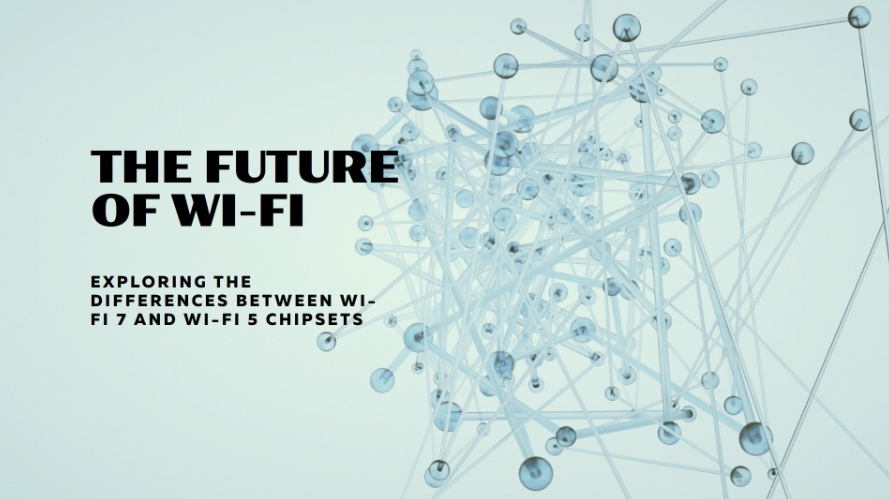WiFi7 IPQ9574 and WiFi5 IPQ4019/IPQ4029 Analyze the technical differences bet...

With the rapid development of wireless network technology, WiFi7 (IEEE 802.11be) is gradually becoming a new industry standard. The IPQ9574 chip launched by Qualcomm, as a representative of WiFi7, has significant performance improvements and technical improvements compared with previous generations such as IPQ4019 and IPQ4029 chips of WiFi5 (IEEE 802.11ac). This article will delve into the key differences between these chips to help readers understand the benefits and innovations of WiFi7 technology.
1. Spectrum utilization and band support
WiFi7 IPQ9574 :** Band support ** : IPQ9574 supports 2.4GHz, 5GHz and 6GHz bands, which can provide wider spectrum resources, thereby reducing network congestion and improving transmission rates.
** Spectrum utilization ** : By using 320MHz channel bandwidth, compared with WiFi5's 80MHz bandwidth increased by 4 times, can greatly increase the data throughput.
WiFi5 IPQ4019/IPQ4029 :
** Band support ** : Only 2.4GHz and 5GHz bands are supported, and mainly rely on 80MHz channel bandwidth.
** Spectrum utilization ** : Relatively low, especially in high-density network environments, susceptible to interference and congestion.
Data transfer rate and throughput
WiFi7 IPQ9574 :
** Transmission rate ** : The maximum theoretical rate is up to 46Gbps, several times higher than WiFi5.
** Multiplexing ** : Support multi-user multi-input multiple output (MU-MIMO) and orthogonal frequency division multiple access (OFDMA) technology, can provide high-speed connections for more devices at the same time.
WiFi5 IPQ4019/IPQ4029 :
** Transmission rate ** : Maximum theoretical rate is 3.5Gbps.
** Multiplexing ** : Although MU-MIMO is also supported, the efficiency and the number of devices supported are not as good as WiFi7.
3. Latency and stability
WiFi7 IPQ9574 :
** Low latency ** : Greatly reduced data transmission latency through improved modulation and demodulation technology (e.g. 1024-QAM), suitable for real-time applications such as online gaming and VR.
** Spectrum Efficiency ** : Efficient spectrum use and more advanced interference management technology make connections more stable and reduce packet loss.
WiFi5 IPQ4019/IPQ4029 :
** Latency ** : Relatively high, not suitable for high-demand real-time applications.
** Spectrum efficiency ** : Low spectrum utilization and interference management capabilities make connection stability poor in high-density network environments.
4. Network security
WiFi7 IPQ9574 :
** Enhanced security ** : Support for the latest WPA3 encryption standard, which provides stronger protection against unauthorized access and man-in-the-middle attacks than WiFi5's WPA2.
** Physical Layer Security ** : New technologies such as random spectrum hopping are introduced to further enhance the security of the physical layer.
WiFi5 IPQ4019/IPQ4029 :
** Basic security ** : Mainly supports the WPA2 standard, although it provides good protection, it is relatively vulnerable in the face of new attacks.
Application scenarios and prospects
WiFi7 IPQ9574 :
** Wide application ** : Suitable for high-density network environment, such as smart home, enterprise office, smart city and other scenarios.As the next generation WiFi standard, WiFi7 will become mainstream in the next few years, widely used in emerging areas such as the Internet of Things, smart home, AR/VR.
WiFi5 IPQ4019/IPQ4029 :
** Traditional applications ** : Mainly used in home wireless network, ordinary enterprise office and other scenarios.
** Upgrade requirements ** : With the increase of equipment and application requirements, the performance and stability of WiFi5 has been difficult to meet modern needs, and gradually replaced by more efficient WiFi6 and WiFi7.
Conclusion
WiFi7's IPQ9574 chip is significantly better than WiFi5's IPQ4019/IPQ4029 chip in terms of frequency band support, transmission rate, low latency, network security and application scenarios. With the continuous growth of wireless network demand and continuous progress of technology, WiFi7 is undoubtedly an important direction for the development of wireless communication in the future. For homes and businesses looking to improve network performance and user experience, upgrading to WiFi7 devices will be a wise choice.
Wallys software technology advantages:Wallys has 10 years of experience in software development and is very experienced in uboot, Linux, wifi protocol, wifi performance, OS and other systems. It mainly uses Qualcomm chips to develop important software such as drivers and kernels, and has the ability to modify and compile to meet customers' different wifi functional requirements. Meanwhile, it participates in openwrt organization and code development. wifi5 product DR40x9 has been officially supported by openwrt.Hardware technology advantages:We have a strong hardware design team, and experienced people know that the most difficult part of hardware design is RF circuit design, baseband, etc., while wallys team made 0 error to achieve signal integrity, such as frequency conversion of network card, from 2.4G to 900M, which is a technological breakthrough.Clients: TIP,Facebook, Openwrt, etcEmail:sales@wallystech.comWEB:https://www.wallystech.com/








评论